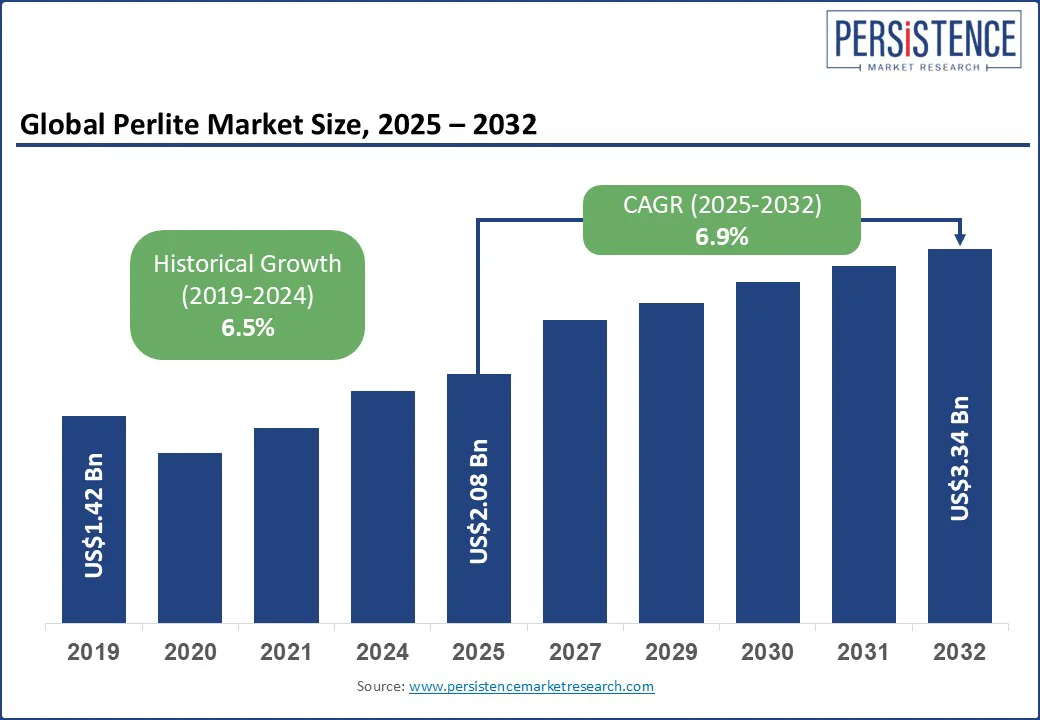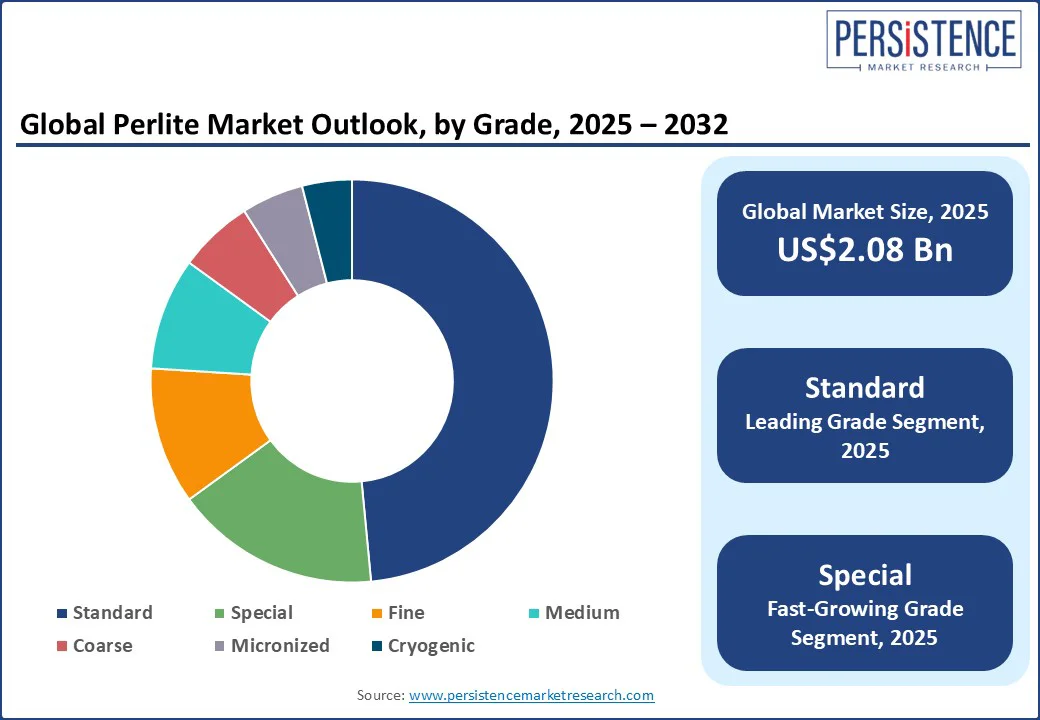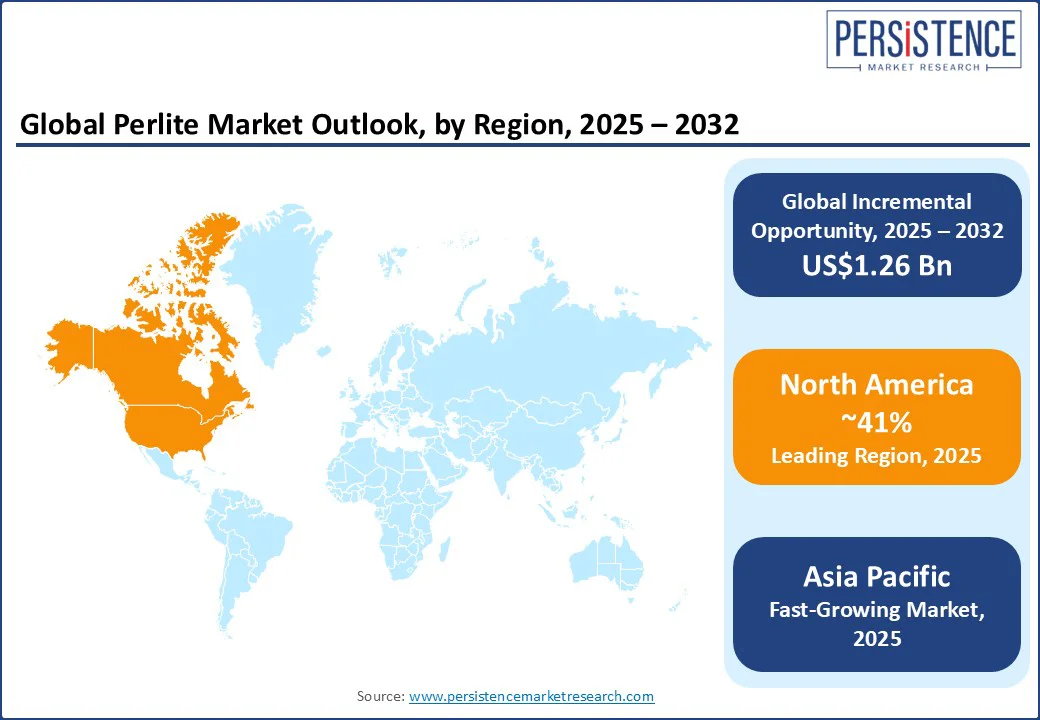ID: PMRREP31687| 186 Pages | 25 Aug 2025 | Format: PDF, Excel, PPT* | Chemicals and Materials

The global perlite market size is projected to rise from US$2.08 Bn in 2025 to US$3.34 Bn by 2032. It is anticipated to witness a CAGR of 6.9% during the forecast period from 2025 to 2032.
Novel developments in the horticulture and agriculture industries, with the rise of hydroponics and controlled environment agriculture, have created multiple application areas for perlite as a soil amendment and substrate.
Perlite is a naturally occurring volcanic glass that, when heated, expands into a lightweight, porous material with exceptional insulation and moisture-retention properties. Its unique combination of being lightweight, chemically inert, fire-resistant, and porous makes it invaluable across a broad spectrum of industries, including construction, horticulture, and industrial. In horticulture, perlite enhances soil aeration and drainage, promoting robust root growth, while in construction, it is popular for its thermal insulation and the ability to reduce the weight of concrete and plaster.
The growing demand for lightweight, energy-efficient building materials in construction is the key driver of the perlite market growth. Along with this, stringent green building material regulations and sustainability initiatives worldwide are also fueling this market.
The growing preference for eco-friendly and non-toxic materials is significantly enhancing perlite’s appeal across industrial and consumer markets. The niche use of perlite in filtration processes within the food and beverage sector and its increasing use in urban infrastructure development across the Asia Pacific and North America are emerging as major growth drivers.
Key Industry Highlights

|
Global Market Attribute |
Key Insights |
|
Perlite Market Size (2025E) |
US$2.08 Bn |
|
Market Value Forecast (2032F) |
US$3.34 Bn |
|
Projected Growth (CAGR 2025 to 2032) |
6.9% |
|
Historical Market Growth (CAGR 2019 to 2024) |
6.5% |
Rapidly expanding construction activities worldwide are driving the market. According to Oxford Economics, global construction output is expected to reach US$13.9 trillion by 2037, driven by ongoing construction activities in China, the U.S., and India. This surge in construction is likely to drive a growing demand for lightweight, energy-efficient, and sustainable building materials worldwide.
As green building regulations tighten and urbanization accelerates, especially in emerging economies, the role of perlite as an indispensable lightweight aggregate in thermal insulation, fireproofing, and soundproofing applications will become increasingly pivotal.
For instance, the U.S. witnessed a remarkable 21.7% increase in privately owned homes in May 2023 compared to the previous month, indicating a rise in the consumption of lightweight construction materials in insulating concrete formulations.
Innovations in circular economy technologies and bio-based perlite alternatives, combined with the construction sector’s rapid evolution, are creating exciting opportunities (fire-resistant materials to advanced acoustic solutions), firmly positioning perlite as a key component of modern construction.
Escalating supply chain volatility, along with stringent environmental and mining regulations, is anticipated to hinder market growth. Perlite mining and processing, inherently tied to extraction activities, face increasing regulatory scrutiny worldwide, especially in the wake of efforts to minimize ecological footprints and preserve natural landscapes.
Restrictions on surface mining and mandatory rehabilitation in prominent perlite-producing countries, such as the U.S. and Turkey, have constrained output capacity, leading to supply-side bottlenecks.
Geopolitical tensions and logistical disruptions have further exacerbated these challenges, driving up raw material costs and inhibiting export flows. These challenges directly impact the availability and pricing of perlite, inevitably slowing market penetration. Moreover, rising competition from alternative eco-friendly building materials and synthetic substrates, combined with the capital-intensive nature of sustainable mining technologies, may further shrink profit margins for market players.
The synergy between urban agriculture growth and advancements in circular economy practices is extending perlite’s relevance beyond its conventional domains. As cities worldwide intensify efforts in vertical farming, hydroponics, and controlled environment agriculture, perlite can prove instrumental as a lightweight, sterile, and water-retentive growing medium, putting itself at the forefront of sustainable agriculture in urban spaces.
For example, rapid urbanization, driven by demographic shifts, is augmenting the demand for efficient soil amendments that maximize yields in limited spaces, which can potentially fuel the deployment of perlite in urban horticulture and specialty crop production.
The shift toward bio-based and recycled perlite products also aligns with broader environmental, social, and governance (ESG) mandates and circular economy trends, optimizing raw material use while reducing environmental impact.
The U.S. Geological Survey’s report of a steady increase in domestic perlite consumption to more than 520,000 tons in 2022 corroborates the rising demand for the material from agricultural and construction markets. Furthermore, advancements in functionalized perlite formulations tailored for multi-industry applications, from renewable energy insulation to filtration media, are set to carve hitherto untapped niches.
Standard grade perlite is anticipated to lead the market in 2025 with an estimated revenue share of 47.5% due to its broad utility across construction and horticultural applications. Its versatile particle size and favorable physical properties make it the preferred choice for use as a lightweight aggregate in concrete and insulation materials.
The sustained global surge in lightweight construction and green building initiatives, especially across North America, Europe, and the Asia Pacific, is anticipated to drive the segment. Increasingly strict energy efficiency mandates for buildings have escalated the demand for expanded perlite insulation and lightweight concrete aggregates, where standard-grade perlite is highly effective. Moreover, rising consumer interest in sustainable horticulture and gardening has further boosted the adoption of standard perlite as an ideal soil amendment and hydroponics substrate.
Special grade perlite is set to experience the highest CAGR through 2032. This grade includes finely milled or surface-functionalized perlite variants utilized in advanced filtration media, thermal-resistant materials, and specialty industrial processes such as aerospace insulation.
Technological advancements in perlite compositions and an increasing demand for functionalized, bio-based, and coated perlite products that meet stringent industry standards are the core growth drivers. For example, the adoption of cryogenic insulation in LNG transport and power generation industries can considerably fuel the demand for specialized perlite with superior thermal properties. Evolving environmental regulations can also encourage the use of sustainable and inert specialty perlite products that minimize ecological impacts.
The expanded perlite segment is anticipated to lead, accounting for approximately 73% of the market share in 2025, owing to its versatile applicability across the construction, horticulture, and industrial sectors. Being lightweight, porous, and thermally insulating, expanded perlite is essential for the engineering of energy-efficient building materials such as insulation panels.
For instance, the increasing adoption of green building codes and sustainability mandates worldwide is likely to elevate the demand for expanded perlite as a sustainable building material. Its horticultural applications in soil aeration and hydroponics are expected to grow, particularly in the rapidly urbanizing markets of the Asia Pacific and North America.
Coated perlite is projected to be the fastest-growing sub-segment with the highest CAGR through 2032. The robust growth is due to technological innovations in lightweight construction materials and emerging high-performance requirements in other industries, such as food & beverages.
Coated perlite products provide enhanced attributes such as improved water resistance, chemical inertness, and thermal stability, thereby enabling industry players to meet the strict requirements in specialized filtration media, advanced fire-retardant materials, and insulation in highly regulated industries such as oil & gas, aerospace, and pharmaceuticals.
For example, coated perlite is increasingly used in cryogenic insulation and selective filtration processes to comply with environmental standards promoting eco-friendly and bio-based materials.

North America, expected to command around 41% of the perlite market share in 2025, remains the largest and most mature consumer of perlite. The region’s resilient construction, industrial, and specialized agricultural sectors will drive market growth. The U.S. is at the center, with more than 919,000 construction establishments recorded in early 2023, supporting a sustained demand for expanded perlite insulation, lightweight concrete aggregates, and fire-resistant materials.
Novel applications for perlite, such as those in cannabis cultivation, can help diversify growth avenues for the market. The regional market also benefits from advanced mining infrastructure and innovations in functionalized perlite products tailored for filtration and cryogenic insulation. Environmental regulations favor the adoption of sustainable and eco-friendly materials, reinforcing perlite’s value as a green building material.
Asia Pacific is the fastest-growing regional market, projected to exhibit the highest CAGR through 2032. Stimulated by rapid urbanization and infrastructure development across China, India, and Southeast Asia, the market in this region is likely to experience a surge in demand for lightweight, energy-efficient building materials such as expanded perlite and lightweight concrete aggregate.
China’s status as the largest perlite producer and consumer underpins the region's supply chain strength and cost advantages. Moreover, growing horticultural activities and rising interest in controlled environment agriculture by consumers in the region have stoked the uptake of hydroponics and vertical farming, boosting market prospects.
Europe is primarily driven by stringent environmental regulations and the EU's strong sustainability initiatives. Recent EU-funded projects (EXPERL) are driving construction companies across the continent to invest in energy-efficient industrial materials, such as lightweight insulating panels and functionalized expanded perlite flakes, thereby expanding market opportunities.
In Germany, for instance, the popularity of urban gardening and organic, eco-friendly horticultural practices has fostered the use of perlite as a lightweight substrate in constrained urban spaces. Enhanced focus on lifecycle assessments and reduced environmental footprints have positioned perlite as a preferred green construction solution in the EU. The region also serves as a pioneer for circular economy approaches to mining and product reuse, offering a highly lucrative avenue for market players.

The global perlite market is entering a new phase, where innovation, strategic oversight, and sustainability will be the key drivers of growth. Top players are going beyond raw extraction, mastering the full value chain, from mining and expansion to precision processing, to inch ahead on the competitive curve and secure product reliability.
Cutting-edge particle engineering, surface treatments, and impurity control are redefining quality benchmarks, while bold moves such as Imerys Mineral’s acquisition of Chemviron’s perlite and diatomite assets strengthen positions in lucrative niches such as filtration, cryogenics, and eco-smart horticulture.
The demand is visibly surging for customized perlite grades that deliver performance and sustainability in equal measure. With regulators tightening carbon and lifecycle standards, market leaders are racing to spearhead greener mining and processing models.
Key Industry Developments:
The perlite market is projected to reach US$ 2.08 Bn in 2025.
The increasing demand for lightweight, energy-efficient building materials in the construction sector is driving the market.
The market is poised to witness a CAGR of 6.9% from 2025 to 2032.
Novel developments in the horticulture and agriculture industries, particularly with the rise of hydroponics and controlled environment agriculture, are key market opportunities.
Imerys S.A., Supreme Perlite Company, and Keltech Energies Ltd. are some key players.
|
Report Attribute |
Details |
|
Historical Data/Actuals |
2019 - 2024 |
|
Forecast Period |
2025 - 2032 |
|
Market Analysis |
Value: US$ Bn |
|
Geographical Coverage |
|
|
Segmental Coverage |
|
|
Competitive Analysis |
|
|
Report Highlights |
|
|
Customization and Pricing |
Available upon request |
By Form
By Grade
By Application
By Region
Delivery Timelines
For more information on this report and its delivery timelines please get in touch with our sales team.
About Author